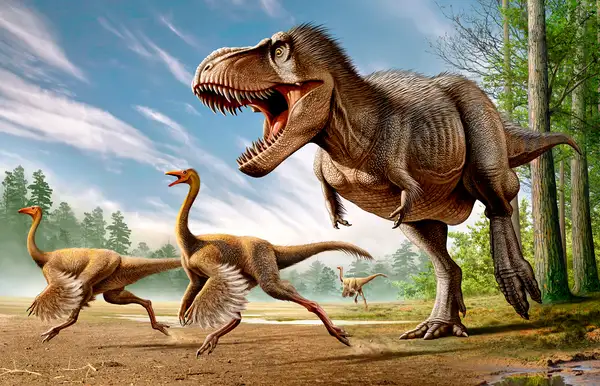With every great discovery in China, the Americas, Antarctica, and elsewhere, science learns more and more about the diversity of dinosaur forms. During their heyday during the Triassic, Jurassic, and Cretaceous periods, dinosaurs evolved to fill the gaps in most ecosystems. Some were large, some were small, some walked on land, some were amphibious, and some dinosaurs even had the ability to fly. But do they have any real honest feathers? Recent research suggests they do, but that's not the end of the story.

For years, science has known that the only remaining descendants of the dinosaur lineage are birds. (So, if someone asks you whether dinosaurs really went extinct at the end of the Cretaceous, you can point out the window at our feathered friends.) One of the most surprising developments in paleontology in recent years is the discovery that, like birds , dinosaurs—in fact, many dinosaurs—had feathers. It stands to reason that if birds have them, they must have evolved into something older, right?
Did dinosaurs really have feathers? In the 1990s, the first dinosaur fossils with feather-like structures were discovered. Further discoveries have led some scientists to believe that all dinosaurs had feather-like coverings on certain parts of their bodies.
Encyclopedia Britannica
Let’s take a quick look at feather designs. The typical feather of modern birds consists of a central shaft (rachis) and a series of paired branches (barbs) that form a flat, often curved surface - the pinnae. The barbs branch into barbules, and the barbules of adjacent barbs are connected to each other by hooks, making the leaves stiff. Many birds have some or all of their feathers without barbules or hooks, and the feathers have a loose, hair-like appearance. The precursors of bird feathers are simple, straight, dense filamentous structures composed mainly of keratin. These eventually evolve into branched, then downy structures that take on a variety of stem shapes but quickly disappear. Over time, this branching condition breaks down into a central stem flanked by leaves that later evolve into barbs.
The first dinosaur fossils with feather-like structures were discovered in the 1990s. Other discoveries followed. By 2011, some studies even suggested that all dinosaurs were covered in some type of feather-like covering on at least some parts of their bodies, just as all mammals have hair, but not all mammals do. Although the first dinosaurs are thought to have appeared about 245 million years ago, feathered dinosaurs date back to only 180 million years ago. However, the story doesn't end there.
Feathers do not appear to have originated with dinosaurs. According to a recent study, they may have evolved in another group. Pterosaurs were a closely related but separate group of "ruling reptiles" (or archosaurs, a group that, by the way, also included birds and crocodiles) that also had feathers. A study of pterosaur fossils published in 2019 described the presence of branched, feather-like structures called dense fibers in pterosaur fossils that date back to about 160 million years ago. These feathers appear in clusters. They are not simple and straightforward, suggesting that feathers predate pterosaurs and dinosaurs and emerged in a common ancestor about 250 million years ago or earlier.
So, did dinosaurs have feathers? They do—and older life forms had them, too.
animal tags:
We created this article in conjunction with AI technology, then made sure it was fact-checked and edited by a Animals Top editor.